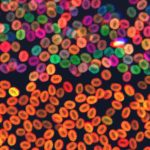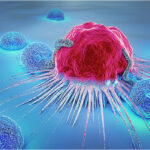A new cancer mechanism: Failed cellular housekeeping

Cancer can stem from mutations in many different genes. New research from Boston Children’s Hospital and Dana-Farber Cancer Institute pinpoints a gene that, when mutated, causes cancer through a mechanism not before seen: Inability of cells to dispose of their trash, namely defective strands of RNA.
This mechanism appears to cut across many different malignancies, and could present a whole new set of cancer targets. The findings were published April 21 in the journal Science.
While studying zebrafish, Megan Insco, MD, PhD, in the lab of Leonard Zon, MD, at Boston Children’s identified a tumor-suppressing gene called CDK13 that, when mutated, expedited the development of melanoma. The same gene was also mutated in many human melanomas, she found.
But what was really surprising was how CDK13 mutation causes cancer. Investigating the RNAs made by melanoma cells, Insco saw, to her surprise, multiple short, defective RNAs. She immediately shared this odd finding with Zon.
“I said, ‘that definitely is interesting,’” recalls Zon, director of the Stem Cell Research Program at Boston Children’s and a member of the Dana-Farber/Boston Children’s Cancer and Blood Disorders Center. “It took years to figure out what it meant.”
A broken vacuum cleaner
It’s normal for cells to make a small amount of short, defective RNAs. But normally, surveillance machinery in the cell nucleus spots these and disposes of them.
“There are hundreds of steps in making RNAs, and sometimes it doesn’t go right,” explains Insco, who now runs her own lab at Dana-Farber. “They’re mistakes that are usually discarded. In this case, we found that the cell was not cleaning them up. The vacuum cleaner was broken, so the RNAs were building up.”
These “junk” RNA molecules, by themselves, dramatically accelerated the progression of melanoma. (In her lab, Insco will investigate whether the effect is due to the RNAs themselves or abnormal proteins made from the RNAs.)
Insco further showed that CDK13 is at the center of the cell’s RNA surveillance/cleanup system. It modifies a protein called ZC3H14 that in turn recruits a complex of proteins to do the work. CDK13 functions the same way in zebrafish, mouse, and human cells, she found.
All told, the work suggests that CDK13 or the proteins it regulates could potentially be targeted to treat multiple cancers. In melanoma alone, 21 percent of the human tumors the team examined had mutations in CDK13 or one of the proteins downstream of it. The team also found mutations in CDK13, ZC3H14, or related proteins in other human tumors, including non-melanoma skin cancer, endometrial cancer, colon adenocarcinoma, and small cell lung cancer.
“There’s a cleanup mechanism that isn’t working in these cancers,” says Zon. “Further defining how RNAs are controlled and processed in cancer will be a major question for developing therapeutics.”
Learn more about research in the Zon Lab.
Related Posts :
-

Genomic 'fingerprinting' yields better treatments for pediatric solid cancers
Genomic profiling is increasingly used for solid tumors in adults and for pediatric brain tumors and blood cancers, allowing treatments ...
-

Preventing leukemia by preventing rogue blood cells from taking over
As we age, many of us acquire mutations that cause some of our blood stem cells to multiply faster than ...
-

An unexpected journey reveals a potent way to attack tumors
Research on the effects of prenatal exposure to the Zika virus has yielded an unexpected dividend: a potentially promising way ...
-

Going out of the box to tackle pancreatic cancer
Pancreatic cancers are deadly and hard to treat, in part because they are so often detected at an advanced stage; ...





